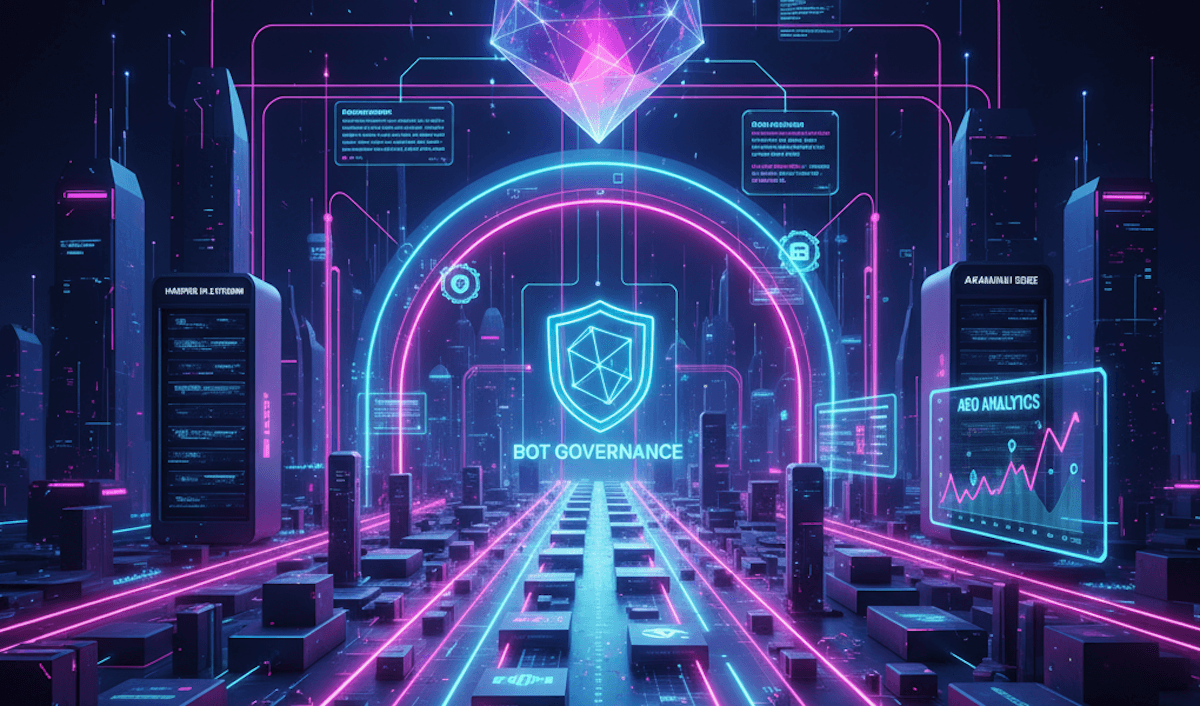Search is becoming an answer feed. Google’s AI Overviews and rivals like Perplexity now summarize the web at the top of results, often pushing traditional blue links further down. Instead of just optimizing for ranking, websites now need to consider how their content is cited, consumed, and controlled inside these new answer experiences.
This shift is what many are calling Answer Engine Optimization (AEO). But contrary to some of the hype, AEO is not a new markup language or secret SEO trick. The fundamentals remain the same: make your content crawlable, structured, and fast. What’s new is that you also need to decide which AI systems you want to power, and which you’d rather block — a decision that blends technical governance with real business impact.
That’s because early research shows LLM-driven traffic converts at nearly the same rate as organic search. The stakes aren’t just about visibility in AI summaries; they’re about securing a stream of future clicks that may eventually drive customer pipeline growth and revenue on par with traditional organic search. In this way, AEO is as much about protecting future business outcomes as it is about optimizing infrastructure.
At the same time, it is essential to note that while AI answer engines are positioned to eventually be powerful traffic drivers, most organizations should still approach them with measured experimentation. The real challenge is scale, not conversion quality. LLM traffic accounts for less than 1% of sessions, while organic search drives nearly a third of site traffic. For these businesses, the prudent recommendation is to focus on thoughtful testing, controlled pilots, and continual discovery.
At the enterprise level, however, Harper and Akamai have already engineered out this risk. By pairing Harper’s distributed application platform with Akamai’s global edge governance, Fortune 100 companies benefit from documented SLAs (.9999 uptime and 95%+ traffic assurance), production-ready infrastructure, and globally consistent performance. This means enterprises can move directly into scalable adoption rather than tentative pilots, capturing early AEO traffic while minimizing risks.
.
From SEO to AEO: Same Foundations, New Stakes
Google has made it clear: there is no special tag for inclusion in AI Overviews. If your content is crawlable, high-quality, and technically eligible, it can be surfaced as a cited source. Success depends on the same Search Essentials that have always mattered: clear site architecture, structured data that mirrors visible copy, and fast load times that meet Core Web Vitals.
What’s new is visibility. When answers are summarized first, only a handful of sites earn the coveted citations beneath the AI output. That raises the stakes: it’s no longer about being one of ten blue links, but one of two or three authoritative citations.
For now, the most practical approach is to prepare content and infrastructure so your site is eligible, while also treating AEO as an experimental channel. This ensures you’re positioned for growth without overcommitting scarce & valuable resources before the revenue impact is fully validated.
The Bot Landscape: Who’s Crawling and Why It Matters
Behind every AI answer is a crawler fetching and training on your content. But not all bots are created equal, and each comes with its own policies.
- Googlebot is still the primary crawler for Search and AI Overviews. Blocking it means disappearing from both.
- Google-Extended governs whether your content can be used to train Gemini. Importantly, opting out here does not remove you from AI Overviews.
- OpenAI operates GPTBot (for training) and ChatGPT-User (for real-time browsing when a user clicks a link).
- Perplexity documents PerplexityBot, which crawls to generate answers and citations.
Robots.txt gives you a way to set policy, but enforcement isn’t always straightforward. Reports have surfaced of bots ignoring robots rules, which is why organizations like Cloudflare have taken stronger measures by default-blocking AI crawlers at the edge. Legal tensions are rising too, with publishers suing Google over AI Overviews’ use of their content.
The takeaway: knowing which bots you’re allowing—and how you’re enforcing those rules—is now a board-level decision, not just a technical SEO tweak. For executives, that decision directly determines how much qualified, revenue-driving traffic these systems can send your way.
Making Your Content “Answer-Ready”
The good news is that the way you prepare your site for answer engines isn’t wildly different from classic SEO best practices. The difference is precision.
- Structure your content so that it can be extracted and summarized cleanly. FAQs, concise explainers, and strong internal linking help. Pair visible copy with JSON-LD schema that matches exactly.
- Optimize performance so bots get content fast. Google is now using Interaction to Next Paint (INP) instead of First Input Delay (FID) as a key metric, raising the bar for interactivity.
- Serve consistent experiences to all users, both consumers and bots. Google approves dynamic rendering as a short-term workaround solution, but the associated infrastructure complexities & technical competence to deliver this solution long term may create the need for additional resources and investment. Instead, a more strategic investment would include solutions like server-side or hybrid rendering that ensure parity with a lower cost & minimal investment entry point.
In short: write content for humans, mark it up for machines, and deliver it fast.
Why Infrastructure Is the Missing Piece
Answer Engine Optimization isn’t just about publishing smarter pages—it’s about how those pages are delivered and governed. That’s where infrastructure plays a decisive role.
On the one hand, platforms like Akamai give you the ability to categorize bots, enforce rules at the edge, and cache responses differently for search crawlers versus human users. For example, you might cache pre-rendered HTML for bots at a long TTL to speed crawling, while keeping shorter TTLs for end-user traffic. Done right, this isn’t cloaking—it’s performance optimization.
On the other hand, modern application platforms like Harper make it easy to generate globally distributed, pre-rendered “answer-ready” content. By serving structured responses at sub-100ms latency, Harper ensures your content is always fast, consistent, and aligned with Core Web Vitals. Together, Akamai and Harper provide the policy and performance layers that make AEO a repeatable, enforceable strategy.
From a business perspective, this infrastructure is what protects ROI. Without it, companies risk losing high-value AEO traffic to competitors with faster, more structured sites — even if their content is equally good.
Measuring Impact and Staying Adaptive
Tracking AEO performance remains a moving target. In Google Search Console, AI Overview clicks and impressions are rolled into the “Web” tab, so measurement relies on aggregate traffic and referral data. Sources like perplexity.ai and chat.openai.com can also highlight AI-driven sessions with UTMs.
Early studies show that AEO traffic can convert at levels similar to organic search. Businesses should therefore monitor not only visibility but also conversion rates, pipeline contribution, and revenue attribution. Framing results in these terms makes the case for continued experimentation.
Still, AEO is new, uneven across industries, and challenging to model with precision. For most businesses, over-investment at this stage could lead to misallocation of resources, making structured experiments and careful measurement the prudent path.
For enterprises leveraging Harper and Akamai, however, the equation looks different. With performance and risk already managed through enterprise-grade SLAs, the recommendation is not about experimentation but about execution. These organizations can confidently scale AEO initiatives today, with Harper ensuring sub-100ms distributed delivery and Akamai enforcing governance and policy at the edge.
Conclusion: Control, Caution, and Opportunity
AEO is not a passing fad; it represents the next evolution in how content is discovered. Success will go to the organizations that combine high-quality, structured content with strong infrastructure and clear bot policies.
By pairing Akamai’s edge governance with Harper’s distributed platform, businesses can deliver content that answer engines can trust and cite, while keeping control over how it is accessed.
The key is balance. AEO should be treated as an emerging growth channel: invest in readiness, experiment thoughtfully, and measure conversion performance closely. That way, you safeguard visibility, capture early wins, and build the data foundation to scale when the channel matures — without falling into premature investments.
In a world where AI is the new front door to information, AEO is not just about being found. It’s about being cited, respected, and prepared to turn AI-driven discovery into business results.







.png)





.png)
